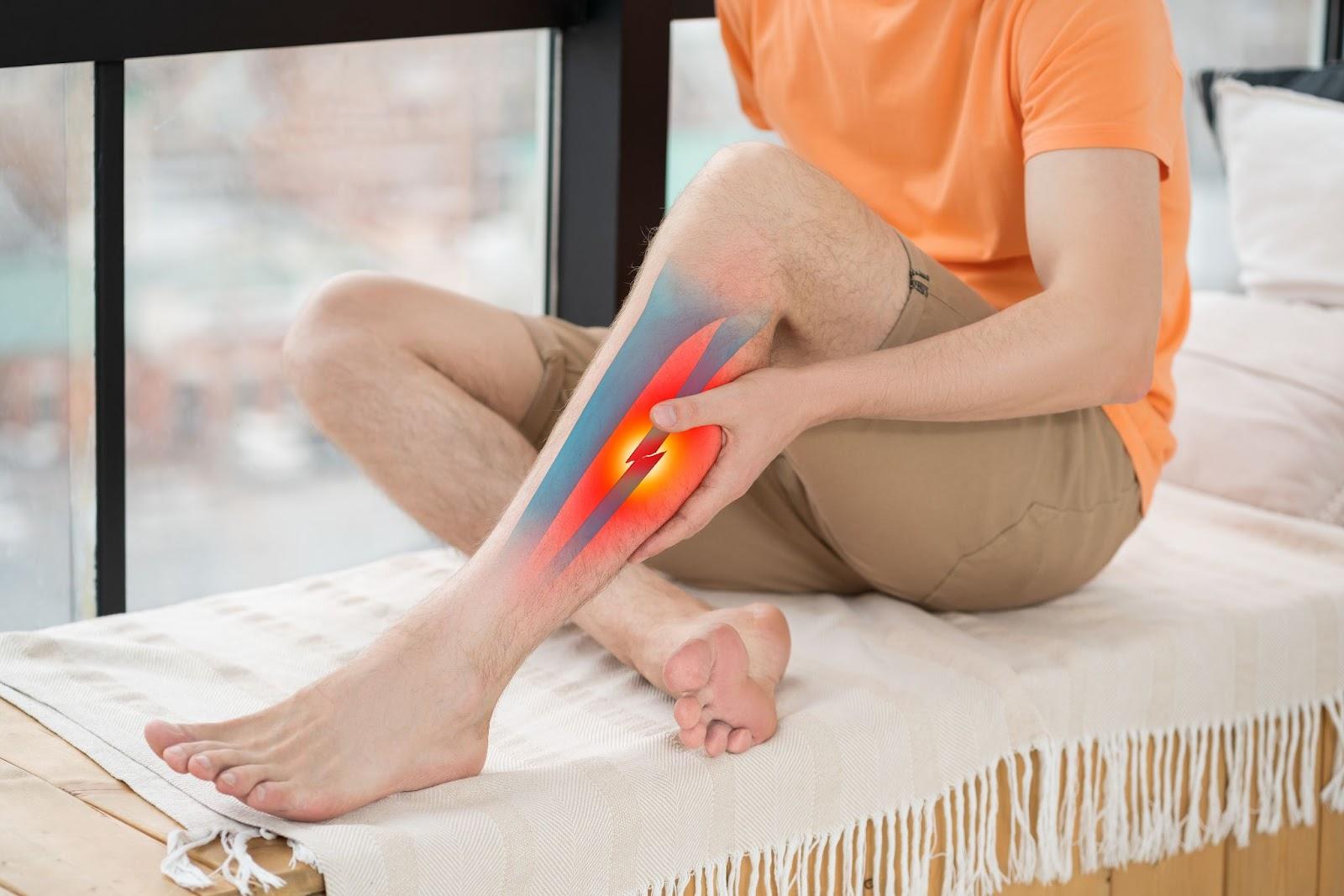Tibia Fracture
What is Tibia Fracture?
A tibia fracture refers to a break in the tibia, commonly known as the shinbone, which is the larger and stronger of the two bones in the lower leg. The tibia is vital for supporting body weight, enabling movement, and connecting the knee to the ankle. Fractures of the tibia are among the most frequently occurring long bone fractures due to the bone’s load-bearing role and its vulnerability to trauma.
Tibia fractures can vary in severity and complexity, ranging from stable cracks to severe breaks involving displacement or multiple fragments. These fractures may occur independently or alongside damage to surrounding muscles, nerves, and blood vessels.
Types of Tibia Fractures
Tibia fractures are categorised based on their location, severity, and the nature of the break. The main types include:
Tibial Shaft Fractures
These fractures occur along the length of the tibia between the knee and ankle. They are the most common type and often result from direct trauma, such as a blow to the leg, or twisting injuries. Tibial shaft fractures can be further classified as:
- Stable fractures — the bone remains aligned, and the break is less severe.
- Displaced fractures: the bone fragments are misaligned and may require surgical intervention.
- Comminuted fractures — the bone breaks into multiple fragments.
- Open (Compound) fractures — the broken bone pierces through the skin, which increases the risk of infection.
Tibial Plateau Fractures
These fractures involve the upper part of the tibia, near the knee joint. They often result from high-energy impacts, such as car accidents or falls, and can lead to joint instability. This type of fracture can damage the cartilage and ligaments in the knee and sometimes, require surgical reconstruction to restore joint function.
Tibial Plafond (Pilon) Fractures
Tibial plafond fractures occur at the lower end of the tibia, affecting the ankle joint. They are typically caused by high-energy trauma, such as falls from significant heights, and can involve both the tibia and its neighbouring bone, the fibula. These fractures are often complex and require diagnostic imaging techniques for diagnosis and treatment.
Stress Fractures of the Tibia
Stress fractures are small cracks in the bone caused by repetitive forces over time, rather than a single traumatic event. These are commonly seen in athletes, runners, and even military personnel. Early diagnosis and management are critical to prevent progression to a complete fracture.

A tibia shaft fracture refers to a break along the middle portion of the tibia, often caused by trauma or twisting injuries.
What causes Tibia Fracture?
A tibia fracture occurs when the force exerted on the shinbone exceeds its structural capacity, causing it to crack or break. This typically results from high-impact trauma, such as a car accident, a fall from a significant height, or a direct blow to the leg during contact sports or physical altercations. The tibia, as a primary weight-bearing bone, is particularly susceptible to fractures under these conditions.
Additionally, twisting or rotational forces can lead to spiral fractures, where the bone breaks in a corkscrew pattern due to the stress of the twisting motion. In cases of repetitive stress, such as prolonged running or intense physical training, micro-damage accumulates in the bone, eventually leading to stress fractures if the bone does not have sufficient time to repair itself. These mechanisms highlight how varying forces — whether sudden and intense or gradual and repetitive—can compromise the integrity of the tibia.
What are the symptoms of Tibia Fracture?
A tibia fracture typically presents with noticeable signs and symptoms, making it easier to identify the injury. These symptoms may vary in severity depending on the type and extent of the fracture:
- Severe pain — intense pain at the site of the fracture, which may worsen with movement or pressure.
- Swelling and bruising — visible inflammation and discolouration around the injured area.
- Deformity — a misaligned or visibly distorted leg in cases of severe fractures.
- Inability to bear weight — difficulty or inability to stand, walk, or put weight on the affected leg.
- Bone protrusion — in open fractures, the bone may pierce through the skin, creating a visible wound.
- Limited range of motion — stiffness or difficulty moving the knee or ankle due to pain or swelling.
- Numbness or tingling — in cases involving nerve damage, there may be a loss of sensation around the injury site.

A tibia fracture can cause intense, severe pain at the site of the break, which may often worsen with movement or pressure.
Who is at risk of a Tibia Fracture in Singapore?
Tibia fractures can affect individuals across different age groups and lifestyles, but certain factors increase the likelihood of experiencing this injury. In Singapore, these risk factors include:
- Active lifestyle — individuals participating in high-impact sports such as soccer, basketball, or martial arts are more prone to tibia fractures due to direct trauma or twisting motions.
- Road traffic accidents — urban living and heavy road usage elevate the risk of tibia fractures from collisions or high-speed impacts.
- Occupational hazards — jobs involving physical labour, such as construction work, increase the likelihood of falls or direct blows to the leg.
- Osteoporosis — older adults with reduced bone density are at higher risk of fractures even from minor falls or injuries.
- Repetitive stress activities — athletes and military personnel engaged in activities like long-distance running or intense training can develop stress fractures over time.
- Children and adolescents — younger individuals are at higher risk due to their active lifestyles and ongoing bone development, which makes their tibia more susceptible to injury.
- Cycling and scooter accidents — with the popularity of cycling and e-scooters in Singapore, accidents involving these modes of transport have become a common cause of tibia fractures.
Awareness of these risk factors can help individuals adopt preventive measures and reduce the likelihood of injury.
How is Tibia Fracture diagnosed?
At Cove Orthopaedics, we understand the importance of an accurate and thorough diagnosis to provide the best possible care for tibia fractures. Our experienced team utilises a variety of diagnostic tools and techniques to assess the extent of the injury and create a tailored treatment plan. Here is how we approach the diagnosis:
- Comprehensive physical examination — our specialists carefully examine the affected leg to assess swelling, deformity, and tenderness. We also evaluate your ability to move the leg and bear weight.
- X-Rays — we utilise X-rays as the primary diagnostic tool to identify the location and severity of the fracture. X-rays provide clear images of the bone to determine whether it’s a simple crack or a more complex break.
- CT Scans — for intricate fractures, such as those involving the tibial plateau or plafond, we may use CT scans to obtain detailed cross-sectional images. This helps us visualise bone fragments and assess any joint involvement.
- MRI scans — if soft tissue damage, such as ligament or muscle injuries, is suspected, we may use MRI scans as they offer a deeper view of these structures.
- Stress fracture assessment — for subtle fractures, especially stress fractures, we may perform additional imaging tests or bone scans to detect small cracks that may not appear on initial X-rays.
What are the treatment options for Tibia Fractures in Singapore?
At Cove Orthopaedics, we believe in providing personalised care for each patient with a tibia fracture. Our approach combines comprehensive medical techniques with patient-centred support to ensure optimal recovery. Depending on the severity and type of the fracture, we offer the following treatment options:
- Immobilisation — for stable fractures, we use casts or braces to hold the bone in place, which allows natural healing over time. This non-surgical approach is effective for fractures without displacement.
- Closed reduction and casting — for fractures where the bones are slightly misaligned but stable, our specialists may perform a closed reduction to realign the bone, followed by immobilisation in a cast.
- Intramedullary nailing — for more complex fractures, we use a minimally invasive technique to insert a rod into the tibia’s marrow canal, which helps ensure stability and promotes quicker recovery.
- Plate and screw fixation — in cases where the fracture involves multiple fragments or joint surfaces, we utilise metal plates and screws to reconstruct and secure the bone.
- External fixation — for open fractures or those with severe soft tissue damage, we may apply an external frame to stabilise the bone while minimising further disruption to the surrounding tissues.
- Physical therapy and rehabilitation — recovery doesn’t stop with the bone healing. Our tailored rehabilitation programmes focus on restoring strength, mobility, and function to the affected leg.
At Cove Orthopaedics, we provide personalised care to support your recovery every step of the way. If you are experiencing symptoms of a tibia fracture, schedule a consultation with Cove Orthopaedics for expert diagnosis and effective treatment plan that can help you get back on your feet.
Frequently Asked Questions
How long does it take to recover from a tibia fracture?
Recovery time varies depending on the fracture’s severity and treatment method. Generally, bone healing occurs within 4 to 6 months, but full recovery, including rehabilitation, may take up to a year.
Can I walk with a fractured tibia?
Walking on a fractured tibia is typically not advised, as it can impede healing and worsen the injury. Your doctor will provide guidance on when it is safe to bear weight on the affected leg.
What complications can arise from a tibia fracture?
Potential complications include infection (especially in open fractures), delayed or non-union of the bone, compartment syndrome, and post-traumatic arthritis. Prompt medical attention and adherence to treatment plans can help mitigate these risks.
Will I need physical therapy after a tibia fracture?
Yes, physical therapy is often essential to restore strength, flexibility, and function to the affected leg. A tailored rehabilitation programme can significantly enhance recovery outcomes.
Are there long-term effects after a tibia fracture?
While many individuals recover fully, some may experience lingering issues such as stiffness, decreased range of motion, or susceptibility to arthritis in the affected joint. Ongoing follow-up with your healthcare provider is important to monitor and address any long-term effects.











